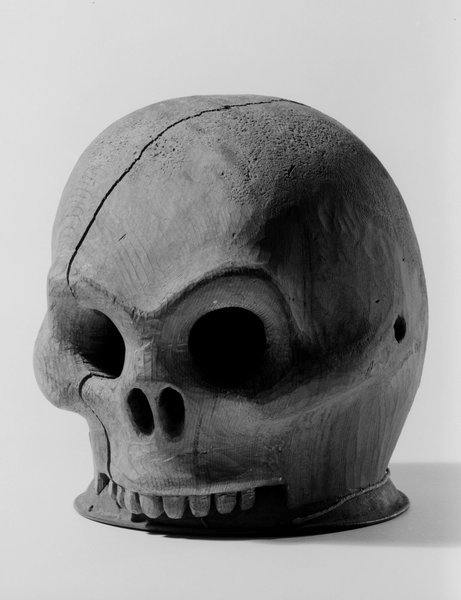Wooden Skull Headdress Item Number: 05.588.7366 from the Brooklyn Museum

Description
The object, in the shape of a skull, was carved from a single, hollowed out piece of wood. Its lower jaw is missing. With four nails, the skull, without its lower jaw, was attached to a metal disk with a dome-shaped center. The object is in stable and fair condition. There is a repaired crack on the proper left side of the back of the skull as well as a repaired splinter at the proper right side of the lower edge. At the top of the skull on the proper right side, there is a large circular wooden plug.
Credit Line
Museum Expedition 1905, Museum Collection Fund
Label
Skull imagery is usually associated with the Tánis (Hamatsa) ceremony practiced by the Heiltsuk and Kwakwawa’wakw people. Young males are initiated into the community during a four-part ritual in which they are symbolically transformed from flesh-eating cannibals, a state equated with death, into well-behaved members of society. The skull thus symbolizes the rebirth of initiates as they come back from the dead. Skull items such as those seen here are sometimes used during the final stages of the ceremony: ritual feeding of the skull, possibly using special ceremonial spoons, precedes a ceremonial meal for the initiates, and the officiating medicine man might wear a skull headdress.
La imaginería de calaveras está usualmente relacionada con la ceremonia Tanis (Hamatsa) practicada por la gente Heiltsuk y Kwakwaka’wakw. Los hombres jóvenes son iniciados a la comunidad durante un ritual de cuatro etapas en el cual son transformados simbólicamente de caníbales devoradores de carne, a miembros con buen comportamiento dentro de la sociedad. La calavera simboliza el renacimiento de los iniciados cuando regresan de entre los muertos. Artículos de calaveras como los que se ven aquí son a veces usados durante las últimas etapas de la ceremonia: antes de la comida ceremonial para los iniciados, se alimenta ritualmente a la calavera, posiblemente con cucharas ceremoniales, y el hombre medicina que oficia dicha ceremonia puede llevar un tocado de calavera.
Item History
- Made between 1868 and 1899
What
Who
- Culture
- Tsimshian
Where
- Holding Institution
- Brooklyn Museum
When
- Creation Date
- between 1868 and 1899
Other
- Location
- Arts of the Americas Galleries, 5th Floor
- Classification
- Clothing